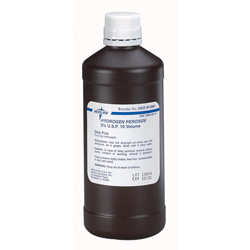The aging process has positive aspects and disadvantages, and a lot of people would agree that
age spots unquestionably fall into the latter category. They may be there for all of the globe to determine and a beacon that middle age has parked itself on your skin. Luckily, age spots could be treated and eliminated. Highly-priced lasers, chemical peels and freezing by liquid nitrogen are all solutions, but you might currently have an affordable approach to erase them your self, at home. Hydrogen peroxide may perhaps be the key to turning back the years.
Age spots, or lentigines, are generally evidence of the sun exposure through the years. Medline Plus of the National Library of Medicine, reports that age spots are widespread soon after the age of 40. They usually happen on sun-exposed locations, for instance your face, forearms, back of the hands, forehead, abdomen, chest and shoulders. You might have heard heard them known as "liver spots," but they've no connection for your liver or its function.
David G. Williams, M.D., owner of an option medical clinic in Texas and researcher, identifies
hydrogen peroxide as "an fascinating substance that should really be known as hydrogen dioxide. Its chemical formula is H2O2. It consists of one extra atom of oxygen that does water--H20." It is colorless and odorless, but not tasteless. It can be harmful if ingested.
New York dermatologist, Dr. Karen Burke, recommends applying hydrogen peroxide on little age spots for an affordable, over-the-counter treatment. This can be not a fast fix, because it could take up to quite a few weeks to obtain rid from the age spot you target. Dr. Burke advises employing 12 percent hydrogen peroxide, usually identified at beauty supply retailers. It's typically utilized in mixture with items to bleach your hair. By contrast, the hydrogen peroxide you could have in your dwelling as a disinfectant is most likely only three percent.
Prior to applying the hydrogen peroxide, distinguish your age spots from other brown marks on your skin. Age spots are flat, light to dark brown or black areas that result from increased pigmentation, and their edges are rarely uniform in look. As you start to set up for this household treatment, be sure to guard against any spilling from the peroxide. At the recommended 12 percent, it could harm any colored surface it touches. Expect the typical foaming observed when hydrogen peroxide tends to make get in touch with using a surface; this is merely an interaction with oxygen.
Dr. Burke recommends working with a cotton swab, dipped within the peroxide. To begin with apply it to one particular little spot to see how your skin reacts. If this can be nicely tolerated, then re-apply it on your age spots, pushing in slightly using the swab. Be cautious to place the peroxide remedy only on the spot itself and don't let it drip down onto your face. This normally takes place when you have absorbed an excessive amount of liquid on the tip from the cotton swab. Hold the swab in spot till slight stinging is felt. Repeat this as soon as every 3 days for several weeks.
After you may have applied the
hydrogen peroxide to your age spots, you could feel a slight burning sensation for up to ten minutes. This can be usual and no lead to for concern. Spots may seem white for as much as four hours. Following the white begins to fade, the spots might come to be pink or red for several days. Soon after several days, expect the spot to scab more than for a handful of more days and then it need to fall off on its own. Do not pick these scabs off prematurely or you may not see the complete impact.


